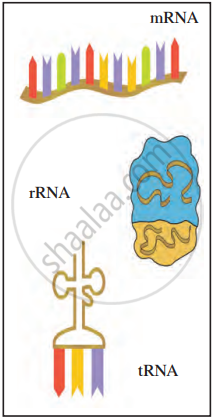Advertisements
Advertisements
प्रश्न
Answer the following question in your own words.
Explain the structure, function and types of RNA.
थोडक्यात उत्तर
उत्तर
RNA is the second important nucleic acid of the cell. This nucleic acid is made up of ribose sugar, phosphate molecules and four types of nitrogenous bases adenine, guanine, cytosine and uracil. The nucleotide i.e. smallest unit of the chain of the RNA molecule is formed by combination of a ribose sugar, phosphate molecule and one of the nitrogenous bases. Large numbers of nucleotides are bonded together to form the macromolecule of RNA. According to function, there are three types of RNA.
- Ribosomal RNA (rRNA): The molecule of RNA which is a component of the ribosome organelle is called a ribosomal RNA. Ribosomes perform the function of protein synthesis.
- Messenger RNA (mRNA): The RNA molecule that carries the information of protein synthesis from genes i.e. DNA chain in the cell nucleus to ribosomes in the cytoplasm which produce the proteins, is called messenger RNA.
- Transfer RNA (tRNA): The RNA molecule which, according to the message of the mRNA carries the amino acid up to the ribosomes is called transfer RNA.

Types of RNA
An RNA nucleotide has three main components - a nitrogenous base, a ribose sugar, and a phosphate group.
∙ The ribose sugar and the phosphates form the backbone of a polynucleotide chain with nitrogenous bases linked to sugar moiety and projecting from the backbone.
∙ Two types of nitrogenous bases are present i.e. Purines (Adenine and Guanine) and Pyrimidines (Cytosine and Uracil).
∙ RNA helps in transforming information present in the form of DNA into protein.
shaalaa.com
या प्रश्नात किंवा उत्तरात काही त्रुटी आहे का?
